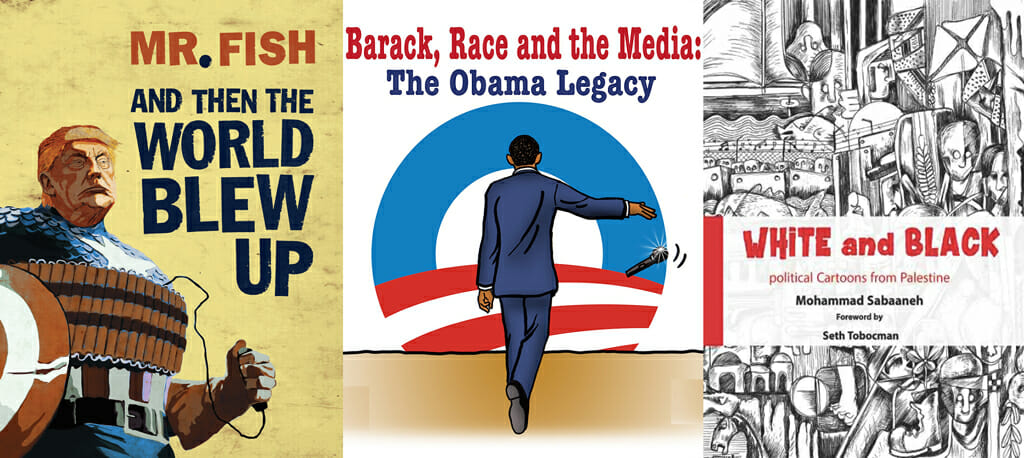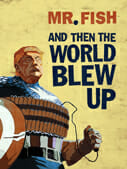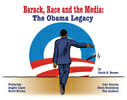Drawing Attention to Ugly Realities
The tradition of subversive political cartoons thrives today, as can be seen in volumes by Mr. Fish, David G. Brown and Mohammad Sabaaneh. Fantagraphics / David G. Brown Studios / Just World Books
Fantagraphics / David G. Brown Studios / Just World Books
“And Then The World Blew Up”
A book by Mr. Fish (Dwayne Booth)
“Barack, Race and the Media: The Obama Legacy”
A book by David G. Brown
“White and Black: Political Cartoons From Palestine”
A book by Mohammad Sabaaneh
In 1831, the great French political artist and cartoonist Honoré Daumier sought to publish a devastating attack on a public figure with his famous lithograph, “Gargantua.”His work pictured a grotesquely obese French monarch, Louis-Philippe, seated on a throne/commode, gobbling up the meager funds of the poor, and then excreting them out to his sycophants and wealthy supporters. Daumier wanted to run this savagely effective cartoon in the newspaper La Caricature. But the government’s censors stopped the publication. Both the publisher and the artist were tried and sentenced to six months in jail—an early example of the suppression of politically critical art and a reminder of the dangers of visual opposition to dominant power arrangements.
Persecution, imprisonment and even death have been the fates of many political artists, including cartoonists, over the centuries. In the United States, politically critical cartoonists have often encountered hostility from government censors and sometimes from their own publishers. A century ago, for example, the U.S. government suppressed the radical magazine The Masses by indicting the magazine’s editors for opposing American participation in the war as imperialistic, denouncing conscription, and supporting conscientious objection. Among its contributors were several prominent successors to Daumier, including John Sloan, George Bellows, Art Young and Boardman Robinson, whose trenchant cartoons could no longer reach their intended audiences.
Contemporary American political cartoonists have fared better on the legal front, relying (if tenuously) on First Amendment protections. Economically, the situation is much more precarious. At the start of the 20th century, newspapers employed approximately 2,000 editorial cartoonists; today, there are fewer than 40.
The daily newspaper political cartoon used to be a staple of the editorial pages. Iconic figures like Bill Mauldin, Herb Block (Herblock), Pat Oliphant, Paul Conrad, Ron Cobb and many others used their caustic pens in mainstream and alternative newspapers to expose the flaws of American social, political and economic life, and often the immorality, depravity and criminality of its major political and corporate leaders. Following in the steps of Daumier and earlier American editorial cartoonists like Thomas Nast and Joseph Keppler from the 19th century and The Masses’ luminaries from the early 20th, they established a standard of excellence that has rarely been rivaled.
Today’s political cartoonists are usually pushed online. There they have multiple avenues for self-expression, but these avenues, at best, provide marginal incomes and make the role and status of the critical political cartoonists precarious. More generally, the decline of the American newspaper, despite the robust nature of online alternative journalism, has insidious long-term implications for democracy.
Still, the tradition of robust political cartooning continues and even thrives, in the U.S. and elsewhere. One of the finest and most trenchant contemporary political cartoonists is Mr. Fish, the name used by Dwayne Booth for his savage visual attacks on the plutocrats, the political miscreants and gangsters, the hypocrisy, and the moral imbecility of our era. Mr. Fish’s cartoons appear regularly in Truthdig, Harper’s, The Village Voice, The Atlantic, and even the Los Angeles Times. His acerbic images and his provocative use of colorful imagery and language would be unacceptable in “family” newspapers and other publications, but they are welcome additions to online journals of progressive opinion and reportage like Truthdig.
His new book, “And Then the World Blew Up,” is an engaging collection of visual works and largely autobiographical verbal commentaries. They are simultaneously visually delightful and horrifying when considering the deeper seriousness of his topics. The verbal parts of the book reveal many of Booth’s childhood and adult experiences, fantasies, observations and ruminations. All of these have collectively informed his powerful visual work, explaining in part his devilish and macabre wit that imaginatively fuses genitalia and scatological imagery, as well as word additions like “fuck,” “bullshit,” “asshole,” and racial, gender and ethnic slurs like “nigger,” “spic,” “wetback,” “raghead,” and “bitch.” He uses these latter words ironically, not pejoratively—something that many progressives lacking in humor (especially sardonic humor) find difficult to handle, which reflects a depressing and long-standing defect in leftist consciousness generally.
Click here to read long excerpts from “And Then the World Blew Up” at Google Books.
Many of Fish’s works, for good and obvious reason, are directed against the brutal and swinish regime of Donald Trump. The cover of the book depicts Trump with a dynamite belt that he is poised to detonate, signifying both the chaos of his administration and, more ominously, its danger to the entire world. The image also shows a tight-lipped, grim-faced Trump looking almost like Benito Mussolini, the Italian fascist dictator he sometimes resembles and whose movements he often appears to emulate.
Other politicians also come under his withering assault. Barack Obama does not escape. The former president is correctly (and perhaps unnervingly to some viewers) depicted as not the legitimate successor of Dr. Martin Luther King Jr. in the panoply of African-American civil rights icons.
Mr. Fish uses his acidic pen to target other worthy subjects in the “fucking world” of the early 21st century. His cartoons address the persecution of Muslims in America and racial profiling, police brutality, plutocracy, corporate greed and misconduct, global warming and environmental degradation, and other problems that place our world in grave danger.

Purchase in the Truthdig Bazaar
Probably Mr. Fish’s most controversial cartoons in “And Then the World Blew Up” are his critical depictions of Israel’s treatments of its Palestinian neighbors and adversaries. Using witty wordplay to introduce that section of the book, “When Jewish Upon a Star,” he offers some works that condemn Israeli aggression and censorship as well as efforts that underscore the perfectly obvious truth that criticism of Israel is not synonymous with anti-Semitism.
Dwayne Booth has created an exemplary body of work that has elevated him to the top rank of American political cartoonists, even though he is relatively young. Although his anarchic and mordant wit probably lacks a universal appeal, it is an absolute delight to those of us who see the absurdity of the world even while trying assiduously to change it. Decades of engaging visual satire from him lie ahead if, indeed, the human species actually manages to survive.
Another outstanding current political cartoonist is David Brown, whose new book, “Barack, Race and the Media: The Obama Legacy” chronicles some of his recent cartoons as well as examples from some of his accomplished contemporaries. Brown emerges from the long but largely hidden tradition of African-American political cartooning, a vital contribution to this genre in both journalism and socially conscious art. Brown continues the work of such distinguished predecessors as E. Simms Campbell, Jackie Ormes, Oliver Harrington and George Lee. Together, their political cartoons and other graphics have allowed audiences to see political and social events from an African-American perspective, a useful corrective to the mainstream white vision that has dominated every medium of American expression since the establishment of the nation.
In contrast to Mr. Fish, Brown has a more positive view of Obama. This is understandable among African-Americans who, a generation ago, could scarcely have imagined a black U.S. president. Brown’s contrast of Obama to the retrograde policies of his predecessor George W. Bush surely makes sense. And doubtless, Obama’s opening of relations with Cuba, his increased funding for health care, his stance on global warming, and his support for LBGT rights, as shown in Brown’s appealing cartoons, deserve praise.

Purchase in the Truthdig Bazaar
Brown’s best political cartoons in this volume reflect his effective critique of some egregious features of American racism. Foremost among these is the continuing police killings of unarmed black people, including such prominent recent cases as Michael Brown, Tamir Rice, Walter Scott, Ezell Ford, Oscar Grant, Philando Castile and too many others. His cartoons about police misconduct and mass incarceration of people of color in America underscore the continuing defects and glaring inequities of the American “criminal justice system.” They should resonate with people of all backgrounds who strive for social justice.
Many of the cartoons that Brown produces for the weekly Los Angeles Sentinel on other social and political issues augment his reputation as a premier political cartoonist. His supportive works on gay rights, for example, are especially significant in a black community where this topic is still touchy even in 2018. Brown’s cartoons on world famine, bank fraud, the dangers of fracking, and other contemporary social and political problems place him solidly in the mainstream of progressive visual journalism and mark him as one of the leading African-American political cartoonists in the early 21st century.
This volume also contains a small sample of political cartoons by Angelo Lopez, David Horsey, Lalo Alcaraz, Steve Greenberg and Tim Jackson. The collection of these multiracial and white artists is a valuable acknowledgment of some of the diversity of contemporary cartooning. While women are not represented here, they too have become increasingly visible in the field and make significant contributions to the satirical visual tradition throughout the nation and the world.
Audiences in the United States rarely take notice of cartoonists from other regions of the world. Even with wide internet access, Americans are usually insular in their viewing and reading habits. Largely unknown here, one of the most powerful voices currently working in political cartooning is a young artist and activist who works for the Palestinian Authority’s daily newspaper, Al-Hayat al-Jadida. Mohammad Sabaaneh produces his cartoons in one of the world’s most contentious regions, where the Israeli/Palestinian conflict seems intractable and where the human suffering is nothing short of unbearable, especially for Palestinians living under a seemingly perpetual occupation.
American viewers now have a unique opportunity to see 180 of Sabaaneh’s cartoons in a dazzling book entitled “White and Black: Political Cartoons from Palestine.” This collection features many achingly powerful works that capture the pain of the daily life of ordinary Palestinians, who endure walls, checkpoints, curfews, abuse by Israeli tanks and bombers, soldiers, and police, relatives in Israeli prison cells, and more.

Purchase in the Truthdig Bazaar
All political artists and their works are shaped by their personal experiences. Sabaaneh’s cartoons result directly from his five months’ detention in an Israeli occupation prison, some of which he spent in solitary confinement. His incarceration gave him a brutally realistic understanding of what it meant to be separated from family and friends. Like all prisoners, he was deprived of life’s simple pleasures that free people take for granted: conversing with loved ones, sipping tea and coffee, basking in the sun.
His experience was similar to that of thousands of other Palestinian detainees who struggle against Israeli occupation and the daily indignities that it has brought to many thousands of women, men and children. But he had a profound advantage as an artist and editorial cartoonist. He could convey these human realities in effective visual form to large and appreciative audiences in Palestine. Now with this book, he can reach out to others who can understand, perhaps even for the first time, the gravity and seriousness of the human tragedy that has been unfolding for too many years in the occupied territories.
All the cartoons in “White and Black” are eloquent documents of artistic resistance. Perhaps his signature work is his graphic adaptation of the famous painting “Guernica,” which Pablo Picasso used to protest the Nazi bombing of the Basque town in 1937 under the orders of General Francisco Franco during his fascist rebellion against democratic Spain. Sabaaneh’s version employs Picasso’s iconic figures while adapting them to contemporary Palestinian realities of rage, frustration, anguish and sorrow. A mother cradles her infant while an Israeli tank stands guard over the Apartheid Wall. A figure leans in, not with a light to illuminate the horrific scene of human destruction, but with a slingshot to signify the youthful weapon of rebellion. The work is a masterpiece of artistic appropriation and sets a high standard for contemporary critical political cartooning.
The most poignant works in this volume are those that depict Palestinians experiencing horrific personal pain. The section on political prisoners is especially powerful and unnerving to view. One example shows an anguished mother and child visiting the husband in prison, as he symbolically seeks to punch through the barrier separating them. Another depicts a woman prisoner behind barbed wired as her pigtail morphs into a chain representing her confinement.
The cartoons showing Palestinians “existing” as hostages in their own land are the saddest of all. But they are also calls to action, urging the end to an unconscionable occupation and relentless mistreatment of human beings that utterly negates the historic Jewish commitment to social justice. Sabaaneh follows in the long tradition of social and political artists who shine the hard light of truth on the ugly realities of injustice, terror and oppression. Like Daumier before him, as well as many others of lesser visibility but perhaps comparable artistic stature, he has paid dearly for his commitment to the truth.
What is to be done? That is the perennial question when confronting the efforts of politically conscious artists. The tentative answer must be to use these incisive works as a catalyst for concerted and collective political action. That is the only way the evils of the Trump regime can be abated, the only way that the scourge of racism can be mitigated, and the only way that the nightmare of Israeli occupation can be ended. Mr. Fish had it right when he discerningly inscribed my copy of his book at a recent Santa Monica book-signing event: “Go save the fucking world!”
Your support matters…Independent journalism is under threat and overshadowed by heavily funded mainstream media.
You can help level the playing field. Become a member.
Your tax-deductible contribution keeps us digging beneath the headlines to give you thought-provoking, investigative reporting and analysis that unearths what's really happening- without compromise.
Give today to support our courageous, independent journalists.






You need to be a supporter to comment.
There are currently no responses to this article.
Be the first to respond.